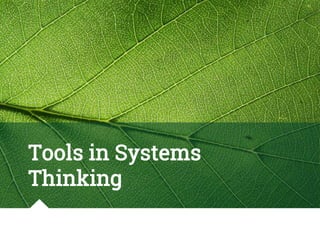
Tools in systems thinking
- 2. AFFINITY DIAGRAM 2 A tool that gathers large amounts of data such as ideas, opinions, issues, facts-and organizes them into groupings based on their natural relationships
- 3. 3 An affinity diagram (sometimes called a KJ method diagram) is a useful way to group tasks, facts or ideas according to themes. It is particularly helpful when you have a large and complex problem that you want to understand. It is often used to analyze brainstorming sessions or survey results.
- 4. 4 1. Write each item on a card. 2. Group related cards into themes. Continue until all the cards are grouped (some may be in groups of 1 card). If this is being done as a team, it is usually recommended that it is done in silence (to avoid unduly influencing each other). 3. Discuss any patterns that have arisen. The steps of creating an affinity diagram are:
- 7. “ 7 ◍ Causal Loop Diagram A tool to map out the patterns of relationships within dynamic systems
- 8. Causal Loop Diagrams • A useful way to represent dynamic interrelationships • Provide a visual representation with which to communicate that understanding • Make explicit one's understanding of a system structure - Capture the mental model SYSTEMS THINKING TOOLS
- 9. 9 + -
- 10. Three Components of Causal Loop Diagrams ◍ Theme 10 Situation or issue that needed solutions Example: What do you do when you are thirsty? ◍ Variables Represent parts of the system that may either increase or decrease Examples: Thirsty and Drink
- 11. 11 ◍ Links, Arrows and Symbols Show the relationship and direction of influence between variables
- 12. Variables - an element in a situation which may act or be acted upon Vary up or down over time (not an event) Nouns or noun phrases (not action words) Links / Arrows - show the relationship and the direction of influence between variables S's and O's - show the way one variable moves or changes in relation to another S or + stands for "same direction” O or - stands for "opposite direction” or B - Balancing feedback loop that seeks equilibrium or R - Reinforcing feedback loop that amplifies change Components of Causal Loop Diagrams
- 13. Types of Causal Loop Diagram ◍ Reinforcing Feedback Loop 13 Theme: “What makes for good student performance?” Variables: Good studying habits and student performance Student Performance Good studying habits + + R
- 14. 14 + - B ◍ Balancing Feedback Loop
- 15. 3. Concept Fan 15 is a way of discovering alternative approach’s to a problem when you have discarded all obvious solutions. It develops the principle of 'taking a step back' to get a broader viewpoint. Initially, the Concept Fan requires you to draw a circle in the middle of a large piece of paper. Write the problem you are trying to solve in the circle. To the right of it radiate lines representing possible solutions to the problem see the diagram below:
- 16. 16 It is possible that the ideas you have come up with are impractical or do not really solve the problem. If this is the case, take a 'step back' for a broader analysis of the problem. Drawing a circle to the left of the first circle does this, writing the broader definition into this new circle and linking it with an arrow to show that it comes from the first circle, see diagram below: Use this as a starting point to radiate out other ideas, if this does not give you an adequate amount of new ideas, you can take yet another step back (and another, and another…)
- 17. Make your concept fan Choose one idea from your affinity diagram, and generate options on how you can fulfil or get what you like, using the concept fan. 17 ◍ In the middle of a blank sheet paper, draw a circle. ◍ Write the problem you are trying to solve in the circle ◍ To the right of the circle, radiate lines representing possible solutions to the problem. Write any solution you can think of. One line, one solution. ◍ To the left of the first circle, draw another circle. ◍ Write the broader perspective using your problem as basis ◍ Link your first circle to the second circle with an arrow, showing that your problem in the first circle springs or roots from the second circle.
